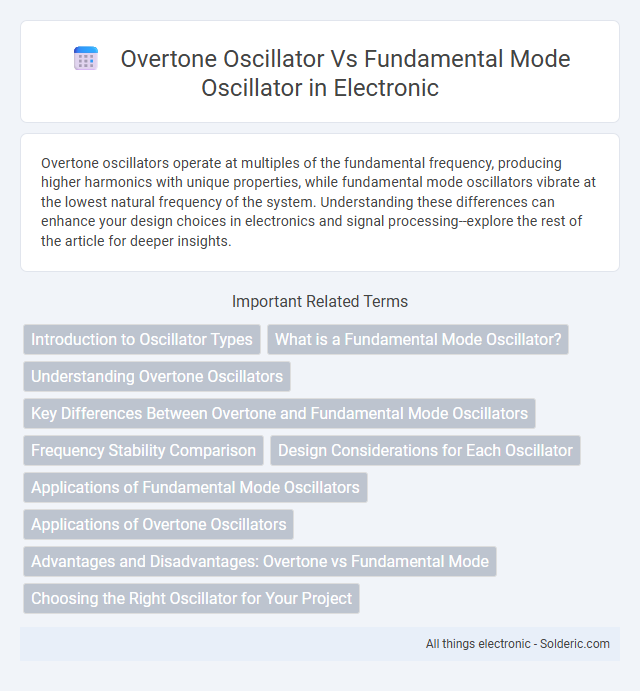Overtone oscillators operate at multiples of the fundamental frequency, producing higher harmonics with unique properties, while fundamental mode oscillators vibrate at the lowest natural frequency of the system. Understanding these differences can enhance your design choices in electronics and signal processing--explore the rest of the article for deeper insights.
Comparison Table
| Feature | Overtone Oscillator | Fundamental Mode Oscillator |
|---|---|---|
| Operating Frequency | Higher harmonics (multiples of fundamental frequency) | Lowest natural frequency of vibration |
| Vibration Mode | Higher order modes beyond the fundamental | Primary or first mode of vibration |
| Frequency Stability | Generally less stable due to mode complexity | Typically more stable and predictable |
| Applications | Used in high-frequency signal generation, advanced sensors | Common in standard oscillators, clocks, and resonators |
| Energy Distribution | Energy concentrated in higher frequency modes | Energy concentrated in fundamental mode |
| Design Complexity | Higher due to mode selection and stability control | Lower, simpler design and operation |
Introduction to Oscillator Types
Overtone oscillators generate vibrations at multiples of the fundamental frequency, producing richer harmonic content ideal for musical and engineering applications. Fundamental mode oscillators vibrate primarily at the lowest frequency mode, offering simpler, more stable signals crucial in communication systems. Your choice between overtone and fundamental mode oscillators depends on whether you need complex harmonic signals or pure, stable frequencies.
What is a Fundamental Mode Oscillator?
A Fundamental Mode Oscillator operates at its lowest natural frequency, producing steady, stable oscillations that correspond to the primary resonance of the system. In contrast to overtone oscillators that vibrate at higher harmonics, fundamental mode oscillators offer simpler frequency control and are widely used in precision applications such as quartz crystal clocks. Their operation ensures minimal frequency drift and enhanced signal purity, making them ideal for high-stability timing and frequency reference sources.
Understanding Overtone Oscillators
Overtone oscillators vibrate at higher harmonics of the fundamental frequency, producing multiple frequencies simultaneously that enrich sound complexity and timbre. Unlike fundamental mode oscillators, which resonate primarily at the lowest natural frequency, overtone oscillators emphasize selective harmonic frequencies, enabling advanced modulation and tonal variation. Understanding overtone oscillators enhances your ability to design systems with precise frequency control and improved spectral characteristics.
Key Differences Between Overtone and Fundamental Mode Oscillators
Overtone oscillators operate at frequencies that are integer multiples of the fundamental frequency, producing higher harmonic modes, whereas fundamental mode oscillators vibrate at their lowest natural frequency. Overtone oscillators often exhibit improved frequency stability and reduced phase noise due to their operation at these higher modes, but require more complex design considerations to suppress undesired harmonic modes. Fundamental mode oscillators are simpler and commonly used in applications demanding lower frequencies or straightforward implementation with reliable amplitude and frequency characteristics.
Frequency Stability Comparison
Overtone oscillators operate at higher harmonics of the fundamental frequency, offering improved frequency stability due to reduced susceptibility to environmental variations such as temperature and mechanical stress. Fundamental mode oscillators, while simpler in design, tend to exhibit greater frequency drift as their frequency is directly linked to the resonator's natural vibration. You can achieve higher precision in timing applications by choosing overtone oscillators when frequency stability is critical.
Design Considerations for Each Oscillator
Design considerations for overtone oscillators prioritize high Q-factor resonators and precise electrode placement to selectively excite harmonic frequencies, ensuring stability in frequency multiplication. Fundamental mode oscillators require simpler resonator structures optimized for the primary resonant frequency, emphasizing low phase noise and temperature stability. Material properties such as piezoelectric constants and mechanical quality factors critically influence oscillator performance in both designs, demanding tailored fabrication techniques to achieve desired frequency accuracy and signal purity.
Applications of Fundamental Mode Oscillators
Fundamental mode oscillators are widely used in applications requiring highly stable and precise frequency generation such as crystal clocks, RF communication systems, and signal processing devices. Their operation at the lowest resonant frequency ensures minimal phase noise and consistent signal quality, making them ideal for timing circuits and reference oscillators in your electronic projects. This reliability in generating clean sinusoidal signals supports critical functions in aerospace, telecommunications, and instrumentation fields.
Applications of Overtone Oscillators
Overtone oscillators are widely used in frequency control and precise timing applications such as quartz crystal oscillators in watches and communication devices due to their higher frequency stability and low phase noise. Unlike fundamental mode oscillators, overtone oscillators operate at multiples of the crystal's fundamental frequency, enabling higher frequency generation without increasing the crystal size. Your choice of an overtone oscillator can enhance signal quality and accuracy in high-frequency RF systems and precision instrumentation.
Advantages and Disadvantages: Overtone vs Fundamental Mode
Overtone oscillators offer higher frequency outputs and enhanced frequency stability, making them ideal for applications requiring precise signal generation, but they can suffer from more complex design and increased power consumption. Fundamental mode oscillators are simpler, more energy-efficient, and easier to implement, yet they typically provide lower frequency ranges and may experience reduced frequency accuracy. You should weigh the trade-offs between complexity and performance to select the most suitable oscillator for your specific needs.
Choosing the Right Oscillator for Your Project
Choosing the right oscillator for your project depends on frequency stability and harmonic requirements, where fundamental mode oscillators offer a pure, stable signal ideal for basic timing applications. Overtone oscillators operate at higher harmonics, providing higher frequencies from lower fundamental designs, making them suitable for RF communication and precision frequency generation. Your project benefits from selecting a fundamental oscillator when simplicity and low phase noise are priorities, while an overtone oscillator suits high-frequency, high-accuracy demands.
Overtone oscillator vs Fundamental mode oscillator Infographic

 solderic.com
solderic.com